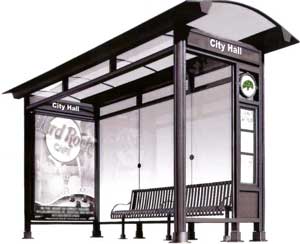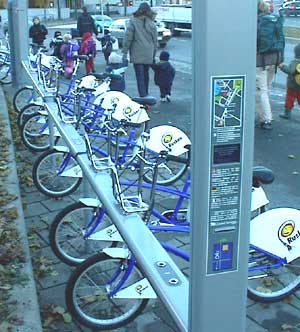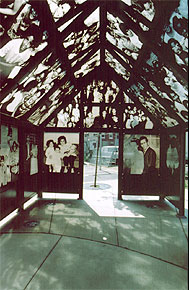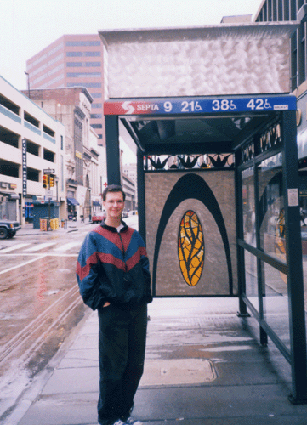DC Bus Shelter Planning
 The "W" version of the Adshel bus shelter for Washington, DC.
The "W" version of the Adshel bus shelter for Washington, DC.I went to the Ward 2 Bus Shelter planning meeting last night since that was the most convenient session for me of the ones scheduled. I was prepared to be skeptical but I am now supportive of the program. My biggest concern was over whether or not they would have options for shelters that are architecturally sympathetic to hsitoric districts. I mentioned last week the bus shelter that Adshel uses in Oakland. It is intended that this be one of the four shelter types used in DC. It works for me.
Clearly, they haven't thought about bus shelters as marketing places for transit, but my comments are likely to help shape that aspect of how they conceive and implement their program.
Not my comments about the necessity of even more increased maintenance at high-volume stops--they propose twice/week cleanup in certain locations, although I aver that might not be enough, but I say that having cleaned the bus stop on my old block many times, and having studied this more systematically (and sweeping up the broken glass from a bus shelter on one occasion) while doing monthly street cleanups on H Street.
Of the four bench types, one is made of a durable Brazilian wood, and that might be a preferred option as it wouldn't get too hot to sit on during the summers.
 Smart Bikes in Oslo. Photo from Oslo Surf.
Smart Bikes in Oslo. Photo from Oslo Surf.The other pathbreaking aspect of the contract is the rollout of Adshel's SmartBike program, which like Zipcar and Flexcar car sharing programs, provides card-based rent-a-bike systems in association with public transportation locations. I had no idea this was part of the DC contract. It looks pretty interesting. This website by the creators of the program, describe how it works in more depth. And here is a paper on the concept, by some Virginians, "Will Smart Bikes Succeed as Public Transportation in the United States" from the Journal of Public Transportation.
Some of the other stuff I talked about concerned localizing shelters with neighborhood information and images, comparable to how Pepon Osorio used images in "La Casita" in Philadelphia (I don't mean this many images, but I like his example of using images).
 La Casita at Congreso de Latinos Unidos, Philadelphia. Pepon Osorio, 2003.
La Casita at Congreso de Latinos Unidos, Philadelphia. Pepon Osorio, 2003.To me, the use of images depicting local history can increase a sense of neighborhood ownership of shelters and decrease vandalism.
Shelters in residential areas won't have advertising. I could kick myself, because only afterwards did I realize I meant to mention that the primary side panel could be used as a "canvas" for public art. Like the stained glass adorned bus shelters in Philadelphia, as depicted in the image below.
 Image from student website at Princeton.
Image from student website at Princeton.Index Keywords: bicycle; transit; street-furniture



0 Comments:
Post a Comment
<< Home